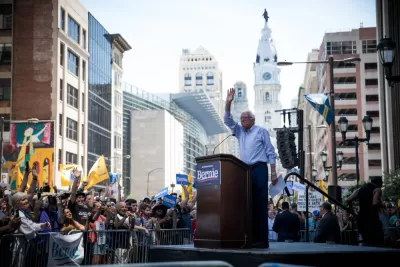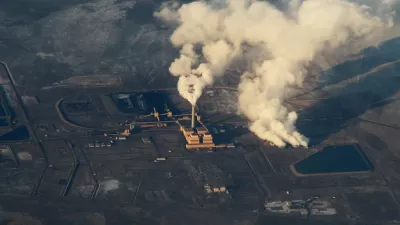CNN host Fareed Zakaria questions whether the goals of Sanders' ambitious Green New Deal are realistic.

"The prospect of Bernie Sanders becoming the Democratic nominee has startled many people who worry that his brand of democratic socialism won’t sell and would pave the way for a second Trump term," writes
"These are laudable though ambitious goals," comments Zakaria. "The question is, how will the United States go about meeting them?" He takes particular aim at the date – eliminating all fossil fuel use in less than a decade would appear unrealistic to him, particularly since Sanders wants to eliminate zero and low carbon power sources noted below.
Citing an analysis by Carbon Brief, a UK-based climate change website, Zakaria notes that carbon emissions in the U.S. dropped 14% form 2005 through 2016, and that the largest reason was the replacement of coal-burning power plants with natural gas plants, which emit just over half the amount of carbon dioxide per unit of energy output than coal, accounting for 33% of the total emissions reduction in 2016. Wind power came in second at 19%, followed by reduced electricity consumption, mostly industrial, at 18%, while solar was responsible for only 3%.
Nevertheless, Sanders is opposed to natural gas. He opposes all new fracking and seeks to ban it nationwide within five years. He also intends to rapidly shut down all gas plants [though the website states "phase out coal and natural gas plants."]
It should be noted that opposition to natural gas power plants and fracking, whether it be for oil or gas, is popular among some mainstream environmental groups today, partly due to methane emissions, which are 25 times more powerful as a greenhouse gas than carbon dioxide, but last only about 12 years in the atmosphere, while "CO2 remains in the atmosphere for a very long time - changes in atmospheric CO2 concentrations persist for thousands of years," according to the Environmental Protection Agency.
One problem with relying solely on renewables for power generation is that wind power accounted for 6.5% in 2018 and solar 1.5%. The largest source was natural gas, at 35%, according to the Energy Information Administration, a division of the U.S. Department of Energy. The nation's third largest source of energy after coal is nuclear power at almost 20%, which Sanders also opposes. Zakariah adds, "In fact, he plans to shut down all of the country’s nuclear power plants within 10 years."
Sanders' Green New Deal relies on a massive increase in energy storage capacity as well as renewable power to compensate for when the wind doesn't blow and the sun doesn't shine.
We will create one more [federal Power Marketing Administration] to cover the remaining states and territories and expand the existing PMAs to build more than enough wind, solar, energy storage and geothermal power plants. We will spend $1.52 trillion on renewable energy and $852 billion to build energy storage capacity. Together, with an EPA federal renewable energy standard, this will fully drive out non-sustainable generation sources.
However, Zakaria says that storage technologies, particularly batteries, are not up to the task, and are cost-prohibitive. And neither is the Sanders plan ready to realistically tackle the climate crisis, concludes the final paragraph of Zakaria's column.
The Sanders green energy “plan” is based on magical thinking. It presumes that we can reduce emissions in electricity and transport to zero in 10 years while simultaneously shutting down the only two low-emission, always-available sources of power that together provide nearly 60 percent of our country’s electricity. And that makes me wonder: Is the real problem that Sanders will lose — or that he might win?
-
Town Hall Spotlights Democrats' Climate Change Proposals, September 5, 2019
-
FULL STORY: Bernie Sanders’s magical thinking on climate change

Maui's Vacation Rental Debate Turns Ugly
Verbal attacks, misinformation campaigns and fistfights plague a high-stakes debate to convert thousands of vacation rentals into long-term housing.

Planetizen Federal Action Tracker
A weekly monitor of how Trump’s orders and actions are impacting planners and planning in America.

In Urban Planning, AI Prompting Could be the New Design Thinking
Creativity has long been key to great urban design. What if we see AI as our new creative partner?

Pedestrian Deaths Drop, Remain Twice as High as in 2009
Fatalities declined by 4 percent in 2024, but the U.S. is still nowhere close to ‘Vision Zero.’

King County Supportive Housing Program Offers Hope for Unhoused Residents
The county is taking a ‘Housing First’ approach that prioritizes getting people into housing, then offering wraparound supportive services.

Researchers Use AI to Get Clearer Picture of US Housing
Analysts are using artificial intelligence to supercharge their research by allowing them to comb through data faster. Though these AI tools can be error prone, they save time and housing researchers are optimistic about the future.
Urban Design for Planners 1: Software Tools
This six-course series explores essential urban design concepts using open source software and equips planners with the tools they need to participate fully in the urban design process.
Planning for Universal Design
Learn the tools for implementing Universal Design in planning regulations.
planning NEXT
Appalachian Highlands Housing Partners
Mpact (founded as Rail~Volution)
City of Camden Redevelopment Agency
City of Astoria
City of Portland
City of Laramie




























